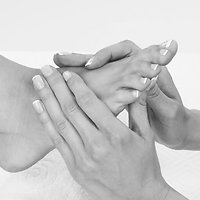About Reflexology
How Can Reflexology Help You?
What Conditions Can it help?
What Benefits Can be expected?
Is reflexology suitable for you?

Reflexology is a complimentary health therapy that is based on the theory that specific points and areas of the feet correspond with different areas of the body. These points and areas are known as reflexes.
The principle behind reflexology is that all parts of the body, including the major organs, muscles, glands and nerves are connected to these reflex points on both of the feet, so that each part of the body has a corresponding reflex area. When these areas are stimulated, a signal is sent through the nervous system to the brain to regulate and improve the function of the internal and external organs of the body as well as its skeletal structure.
By using specific techniques, the nervous system is affected in a positive and relaxing way. With the body relaxed and the nervous system stimulated, healing has a perfect opportunity to take place.
When gentle pressure is applied to the reflex areas its stimulating effect can strengthen and balance the body's systems. This then encourages the body's own healing process to be stimulated, which in turn brings about a state of homeostasis (balance and harmony) and relaxation.
Because reflexology is a complimentary therapy it can bring complete relaxation, allowing it to be integrated and used alongside conventional medicine to great affect. Considering it’s therapeutic effect there are few contraindications to its application.
The History of Reflexology
From ancient texts and illustrations we know that as far back as 4,000 B.C. the ancient Egyptians and Chinese worked on the feet to promote good health.
Although there were many eminent individuals who researched its ancient beginnings to positive effect, the therapy was not introduced to the western world until the late 1800s. This was when Dr William Fitzgerald, an ear, nose and throat specialist, introduced 'zone therapy'. He discovered that the body’s energy flows through ten longitudinal zones, which run from foot to head. Through much research he concluded that pressure applied to a reflex point in one zone of the foot, can create a positive direct response in the related body area.
In the 1930’s, US physiotherapist Eunice Ingham further developed zone therapy into what has now become the foundation of modern reflexology. With what she called her ‘Reflex Method of Compression Technique’, she also understood the benefits of stimulating the circulation and nerve impulses, as well as applying pressure to specific areas of the feet to promote good health. To this effect she produced detailed maps of the feet and hands that are seen as the blueprints for practitioners today. It is these foot maps and many of her early techniques that have developed into what is now known as reflexology.
How Can Reflexology Help You?
It is acknowledged that 75% of all illness is stress related. In today’s modern world, when we fail to properly manage our stress and anxiety levels, it can lead to our immune systems becoming compromised, leaving us more susceptible to illness and disease.
Many conditions are multilayered – some needing conventional treatment, whilst others do not. Given the correct conditions, Reflexology aims to bring the body back towards normal function and reduce stress.
Reflexology reduces stress by creating deep relaxation and a sense of balance and well-being. It helps to calm down the nervous system and allows the body to function more efficiently by the opening and clearing of neural pathways, helping it to return to its natural rhythms.
What Conditions Can It Help?
Here are just some examples of the conditions that I treat regularly:
- Anxiety
- Arthritis, Osteoarthritis & Joint pain
- Asthma
- Back, Neck & Shoulder pain
- Circulatory problems
- Constipation
- Depression
- Eczema
- Endometriosis
- Fertility - pre-conception, pregnancy & post-natal
- Fibroids
- Fibromyalgia
- Hay fever
- Hormonal imbalances
- IBS
- Insomnia
- Menopause
- Migraine & Headaches
- Osteoporosis
- PMS
- Polycystic Ovarian Syndrome (PCOS)
- Polymyalgia Rheumatica
- Psoriasis
- Sinusitis
- Sports Therapy
- Stress related conditions
- Tinnitus
- Well-being & Relaxation
What Benefits Can Be Expected?
Reflexology reduces stress (a major contributing factor to disease), enhances the body's ability to heal itself and balances both body and soul. Amongst many other benefits, research shows that a single reflexology session can create relaxation, reduce anxiety, relieve fatigue, boost energy levels, diminish pain, improve blood flow, decrease high blood pressure and help improve quality of sleep.
Is Reflexology Suitable For You?
Reflexology is a therapy which can be received by anyone at any age, from newborn babies to those facing end of life care, and everyone in between. However, there may occasionally be times when it is not suitable to provide a treatment. The best advice I can give you is to give me a call and ask!
Reflexology is a complementary therapy and can therefore be used alongside other medical treatments. However, It should not be used as an alternative to seeing your Doctor or taking medical advice.
